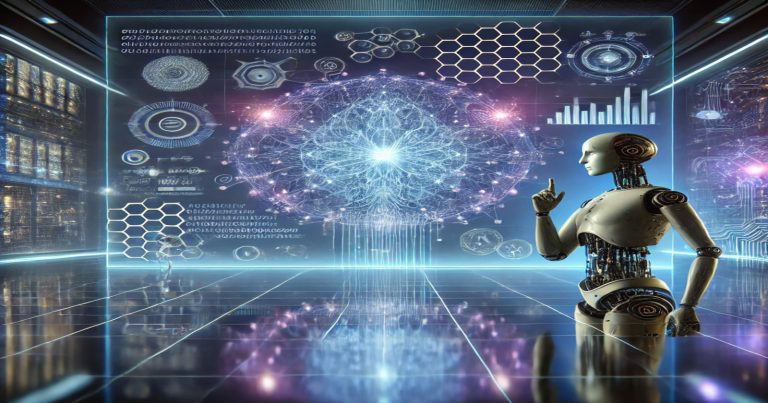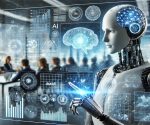The world of work is being transformed by data science and artificial intelligence. These areas of study enable computers to learn, make decisions, and solve problems, similar to humans. Data science is the process of gathering and interpreting a large amount of data. That data is used by artificial intelligence to develop intelligent systems that operate autonomously. The solution for data science and artificial intelligence is making better decisions, quick services, and smarter technology. Today, they are used in every industry—by banks, hospitals, schools, and factories. Combined, they unlock new opportunities for rapid growth and better quality of life.
Connection Between Data Science and Artificial Intelligence
How do you teach machines to learn from previous data? They analyze this information and make predictions or decisions. This informs people and businesses what to do next and takes the guesswork out of the equation. So, in this segment let us explore how machine learning learns and works and contributes to smarter business decisions.
Also, below I just went through the basic concepts of data and arranged them in a way that there is a very short sentence comprising just 3 to 4 words, which, if you understand, you can take your ML skills to the next level.
Machine learning algorithms are like intelligent students. They learn from examples and from studying them. After they figure out the patterns, they transfer that learning to new problems. The more examples they see, the more intelligent they become. This is supervised learning, we have the labels in our data. For example, to teach a model to tell cats from dogs, we show images labeled cat and dog. It then learns a differential. In unsupervised learning, the model learns patterns by itself. One of these methods is clustering which groups similar items. Reinforcement learning is based on incentives. It learns by trial and error and with feedback.
Different algorithms work differently. If, for instance, decision trees are queries/follow questions to assess and give a follow-up to a flowchart. Linear regression examines numbers to forecast an outcome. K-nearest neighbors look at similar data to predict the right answer. They all rely on data and data quality and availability. Machine learning cannot work without data.
These models learn how to improve these decisions as they train. For instance, Netflix uses algorithms to suggest movies. For example, Amazon recommends products based on previous shopping information. These systems just keep learning and getting better.
Data-Driven Decisions in Practice
In the world of today, educated guesses don’t function. Machine learning algorithms make better decisions at scale for smarter companies. Such decisions drive better outcomes while saving money and decreasing errors. Predicts diseases using records of patients in the hospital A factory uses machine data to predict the moment a part will fail. Such forecasts can save both time and lives.
You open a food delivery app and the app recommends food you may like. It analyzes what you ordered in the past, what customers in your area prefer, and even the time of day. That’s data in action. This is where data science and artificial intelligence work hand in hand to ease up your life. Individually and collectively, they lead individuals in relatively simple yet effective ways, simply by cleverly applying historical data.
Artificial Intelligence in Business Transformation
Here are some examples of how AI is helping businesses grow better and faster. It alters how businesses operate, communicate with customers, and strategize. Businesses use AI to provide better services, minimize costs, and make more informed decisions.
What is AI in Business?
In business, AI represents the utilization of intelligent tools that process information, learn, and make decisions. These tools analyze data, discover patterns, and assist managers in selecting a course of action. AI takes slow work done by humans and replaces it with work done quickly by computers. It also reduces errors and contributes to better results.
Case in point, a company receives lots of user questions daily. It trains a chatbot using AI. Now the robot responds quickly to the occasional simple question. This provides time saves on the customer service side. It also ksavingsusers happy. When more people are happier, business does better.
AI also reads data on previous sales, customer behaviors, and reviews. It then tells managers people’s favorite products, what to change, and when to run a sale. This provides a straightforward road for the business to navigate. The result? Less losing, more planning, more profit
What AI is doing in Various Sectors?
AI delivers intelligent solutions to every sector of work:
- Retail: Stores rely on A.I. to figure out what shoppers need. IAIsists with inventory management and prospecting. It analyzes spending patterns and alerts to risky behaviors.
- Transport: AI is employed by companies to algorithmically plan the fastest and safest routes. It helps save fuel and time.
- Even schools use AI now. It tracks students’ progress and recommends lessons that match their pace. AI is used by hotels to price their rooms according to demand. This is a demonstration of how business artificial intelligence is integrated in all fields. These changes occur thanks to powerful data and intelligent tools. That is the reason data science & artificial intelligence never fades in the context of business.
Best Data Analytics Tools Currently Used in the Industry
Data analytics tools assist humans in interpreting figures. These tools clean and sort data and present it in charts and graphs. They are used to plan intelligently based on facts.
Popular Data Analytics Tools
Today’s data tools are abundant. Some help with numbers. Others help make charts. Some are good for coding. Each one has a use. The following is a table of commonly used tools:
| Tool | What it Does |
| Python | Helps in coding, machine learning, and data handling |
| R | Good for stats and drawing graphs |
| Tableau | Turns data into pictures and dashboards |
| Power BI | Easy tool for reports and linking data |
| Excel | Common tool for tables and small tasks |
| SQL | Finds and changes data in databases |
| SAS | Used by big companies for heavy data work |
As for Python, its versatility in covering all aspects of data science and AI is a big reason for its popularity. R is great for people who do deep stats work. Tools like Tableau and Power BI present pretty charts that tell the story behind the numbers.
Relevance to ACCA Syllabus
Data science and artificial intelligence are exciting, emerging trends that are transforming how finance professionals are engaging with datasets, automating workflows, and generating financial insights. AI is accelerating audit processes, risk assessment, and decision-making using predictive analytics and automated systems that ACCA candidates need to know. AccA has emphasised digital skills in its papers relevant to the corporate world, including the ACCA’s Strategic Business Leader (SBL) and Audit & Assurance (AA), with a focus on including AI-based tools for the preparation of financial statements and audit analytics.
Data Science and Artificial Intelligence ACCA Questions
Q1: Modern audit practice in external audits includes AI.
A) Manually test every single data entry
B) Predicting future profits
C) As in determining risk and patterns in data
D) Take over the function of outside auditors
Explain: C) Risk assessment and data pattern recognition
Q2: True or False question, please provide the name of the data science technique/tool from the choices below that best describes the concept of financial fraud detection.
A) SWOT Analysis
B) Blockchain Ledger
C) Predictive Modeling
D) Ratio Analysis
Ans: C) Predictive Modeling
Q3: Where do you see financial reporting as producing the most return for data science?
A) Basic journal entries
B) Manual reconciliation
C) Analyzing Trends and Predicting
D) Office administration
Ans: C) Trend analysis and forecast
Q4: What would you consider the role of AI in risk management in audit assurance?
A) By guessing risk levels
B) Searching through large swathes of data for red flags
C) And rather than managing decisions
D) By signing audit reports
Ans: B) Scanning the big data for red flags
Q5: What is the concept?
A) Regression models
B) Traditional trial balance
C) Paper-based audits
D) Manual entry logs
Ans: A) Regression models
Relevance to US CMA Syllabus
Data Science, as I said earlier, is built on advanced analytics, and you will find it embedded in the US CMA syllabus, wherever you see strategic financial management, decision analysis, performance management (etc) — or data science is backing US CMA budgeting, forecasting and cost management. It is also critical for strategic planning and control, as AI tools also automate variance analysis, assess investment decisions, and optimize resource allocation.
Data Science and Artificial Intelligence CMA Questions
Q1: In what ways will AI-tools improve budgeting subject to managerial accounting?
A) Manually entering historical expenses
B) Exclusively through cash flow tracking
C) Analyzing trends and automating predictions
D) By filing tax reports
Ans: CTrend analysis and forecast automation
Q2: Name one specific use of data science in cost analysis?
A) Reviewing printed reports
B: Measurement of cost behavior: variable and fixed costs
C) Preparing vouchers
D) Calculating tax refunds
Ans: B) Variable & Fixed cost behavior
Q3: What is the name of the AI application used by CMAs to detect anomalies in large datasets of expenses?
A) Blockchain
B) RPA (Robotic Process Automation)
C) Clustering algorithms
D) SWOT analysis
Ans: C) Clustering algorithms
Q4: What data-driven performance measurement technique predicts future performance?
A) Ratio analysis
B) Predictive analytics
C) Cash accounting
D) Balanced scorecard
Ans: B) Predictive analytics
Question 5: How is AI helping with variance analysis?
A) It will performance gain on comparison to less important variance
(b) that it relies on manual verification
C) It triggers automatically for large differences
It also only tracks favorable variances)
Ans: C) It automatically identifies significant differences
Relevance to US CPA Syllabus
The US CPA syllabus consists of fundamentals like accounting and auditing, business surroundings, and financial reporting, etc. With digital tools becoming more central, CPAs should understand how business artificial intelligence makes audits, internal controls, and tax planning more efficient. Understanding AI is also needed as the role of CPA in analytics-based auditing and financial advisory, the practice of risk-based audits, and fraud detection evolves.
Data Science and Artificial Intelligence CPA Questions
Q1: What advantages do internal audits have from leveraging AIs?
A) more paper-based recordkeeping
B) All manual controls used
B) Collection and Risk assessment
D) Abolishing audit standards
Ans: C) Live data analysis & risk monitoring
Q2: What is the data science concept that YES plays into in terms of analysis to support revenue recognition?
A) Sentiment analysis
B) Neural networks
C) Time-series forecasting
D) Supply chain mapping
Ans: C) Time-series forecasting
Q3: In which area of tax planning can A.I tools be of most assistance?
A) Manual tax form filling
B) You may have to look for deductions and risks
C) The production of handwritten ledgers
D) File archiving
Ans: B) Identifying deductions and risks
Q4. Ayad Akhmed, a QA at an AI-powered automatic audit fraud detection and prevention solution.
A) Data sampling only
B) Deep learningAnomaly detection
C) Checking paper vouchers
D) Looking at historical financial statements
Ans: B Deep learning for data and anomaly detection
Q5: What technology can help CPAs tin automating journal entries?
A) Manual spreadsheet tools
B) Dashboards with data visualization
C) Robotic Process Automation (RPA)
D) SWOT matrix
Ans: RPA (Robotic Process Automation)
Relevance to CFA syllabus
CFA Exam places a greater emphasis on financial tools, portfolio management, t, and financial reporting. The CFA curriculum covers quantitative methods, learning, g , and big data as AI-powered algorithms underpin portfolio strategies. Armed with skills in forecasting market trends, risk modelling and behavioural finance, analysts who are trained in data science are right in the middle of the investment action, trading on prediction backed by AI.
Data Science and Artificial Intelligence CFA Questions
Q1: What data science tool is especially utilized to construct the most efficient portfolios?
A) Ratio analysis
B) Monte Carlo simulations
C) Accounts payable ledger
D) Inventory turnover
Q7: Ans: B) Monte Carlo simulations
Q2: Which AI technique is used to analyze the behavior of investors in the context of financial markets?
A: Generating behavioral finance model
B) Trend line drawing
C) Bank reconciliation
D) Variance reporting
Ans: A) Behavioural finance mo delling
Q3: If AI makes this possible for risk modeling and scenario planning, which AI magic pulls the strings?
A) Deep fake generation
B) Clustering
C) Sensitivity analysis using machine learning
D) Basic data tabling
Ans. C) Sensitivity analysis based on machine learning
Q4: How does AI help to analyze financial statements for investment analysis?
A) By decoding cryptic notes
B) By creating human insights
C) Detects automatically patterns and trends
D) By looking past low-profit firms
Ans: C) Automatically detecting pattern and trend
Q5: Which of these statements best describes AI in algorithmic trading?
A) Drawing up of broker agreements
B) Following rules defined by the trader and the market data, automated trading
C) Printing market summaries
D) Investor newsletters
Ans: B) Executing trades based on rules made in advance and data that is live


